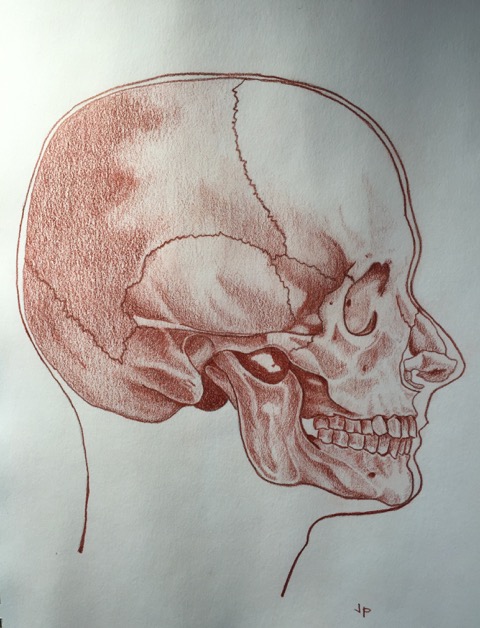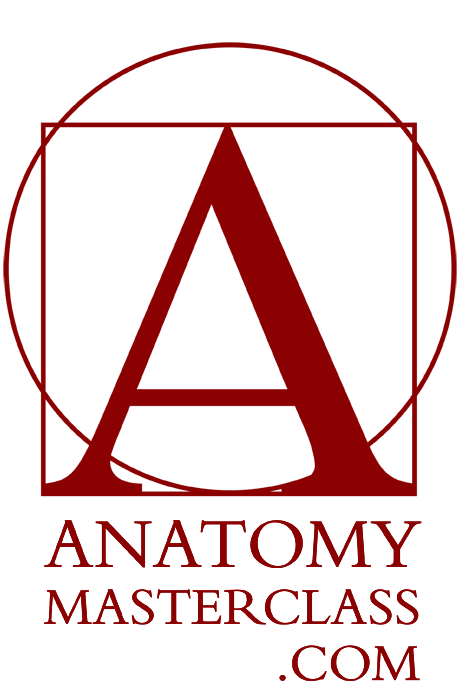Anatomy drawing skills in doctor’s practice
Drawings and feedback from Dr. Valérie Julie Brousseau

Here are two anatomical studies in red pencil for which my aim was to review relative anatomy and work on drawing skills and rendering shades. These are my two first experiments with red. I liked it but found it challenging: it does not forgive – just like surgery!
I based myself on an anatomy book which I knew well. But it is not the same to draw as to look: the relationships of structures become more obvious with drawing as one needs to think of exactly where everything fits on to bone etc. I shall send you more as I go along… I am hoping to try silver point soon: am just getting the material together, it is not easy… Thanks for the videos, they are great.
I have already subscribed to your Drawing Academy Course and have really enjoyed it. Which is why I could not resist trying the Anatomy one. I always dreamt of doing oils one day, as I work on my skills with your help, this day may be closer than I thought!


As a subspecialty surgeon, I often have to reconstruct structures in the face as well as to document specific steps of an operation – for a report, a chart, or a publication. Photos in the office and the operating room have become common practice. However, that type of documentation has its limitations for several reasons: some aspects of surgery are microscopic, such as in ear or laryngeal surgery, other aspects require documentation of relative structures and movement of tissue, muscle or nerve. This cannot be easily demonstrated on a picture, even with sequential shots.
I find drawing is a much more efficient, reliable and precise way of describing surgical steps and reconstructive techniques. The Drawing Academy and Human Anatomy courses have provided me with the skills necessary for me to document my surgeries with ease and precision. The quality of its anatomical references and details has also provided me with a deeper understanding of human body aesthetics and the impact of individual structures on local and global aesthetics.
I would be hard pressed to find a classical art teacher able to deliver such an excellent course, and even then, I would probably not be able to attend due to my busy schedule. The online aspect of the course allows me to work at my own pace, when I want, where I want – and still get the best training and advice in classical art.
Congratulations to Vladimir London and Natalie Richy for putting together a fantastic course!
Dr. Valérie Julie Brousseau, BScH, MDCM, FRCSC
Dr. Valerie Julie Brousseau, otolaryngologist, head and neck surgeon is a Fellow of the Royal College of Surgeons of Canada and has worked at Hotel Dieu d’Arthabaska, Victoriaville since 2008 where she acts as departmental chief since 2014. She holds a Bachelor of Science with Honors in evolution and genetics from the University Acadia (2000), an MD with Master of Surgery from McGill University (2004) where she also completed her post-doctoral training in otolaryngology, head and neck surgery (2009). Among other things, she was a recipient of the Fellowship of the National Council for Research in Science and Engineering for her work in genetics, the Silver Jubilee prize of Queen Elizabeth II, as well as the Clark E. McLeod and Canadian Millennium scholarships throughout medical school. Her clinical and scientific research have been presented at national and international conferences and won several awards. She has published over 25 medical articles in scientific journals. Apart from her medical profession, she owns Taliah, a business specializing in East Friesan sheep farming and Ewe Cheddar production located in St Christophe d’Arthabaska, Québec, Canada where she lives. Her farm also raises organic livestock to provide food for people in need.
Learn human body anatomy and proportions quickly and easily
One-time payment - Lifetime Membership
$97 USD




